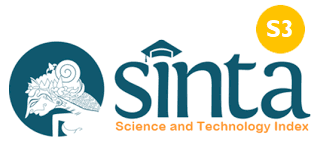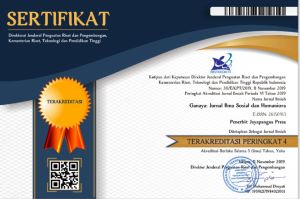Komunikasi Organisasi dan Kemitraan Antara Airside Operation Unit Angkasa Pura II Palembang dan Mitra Maskapai
DOI:
https://doi.org/10.37329/ganaya.v6i3.2658Keywords:
Organizational Communications, Partnerships, Angkasa Pura II, AirlinesAbstract
Angkasa Pura II Palembang is an international airport that is quite good in development seen from neat, clean tenant arrangements, good security, and adequate facilities. In implementing good airport operations, it is necessary to pay attention to how to build good relations between Angkasa Pura II managers, especially the Airside Operation Unit and the airlines. This study aims to identify and describe the organizational communication of the Angkasa Pura II Operations Unit in building good relations with Citilink's partner airlines. The theory used is the theory of organizational communication and partnerships. The research method used is descriptive qualitative. The subjects of this study were 2 people, including 1 OASA Manager and 1 Manager. Data collection techniques use primary data, namely interviews, and secondary data, namely observation, documentation and literature study. The technique of analysis and testing the validity of the data uses source triangulation. The results of this study indicate that the Airside Operation Communication Unit through various activities, namely meetings, meetings, morning coffee, community airlines (AOS), safety activities, Strategy Incentive Screen, Free-Lends. Keep in touch, both via e-mail and face to face. As well as regular meetings held once or twice a month. The partnership implemented by Angkasa Pura II and Citilink is a Potential Partnership. In this type of partnership, the partners care about each other but have not worked closely together.
References
Andrika, M. Z., Simamora, P. R. T., & Perwirawati, E. (2023). Komunikasi Organisasi Airport Security PT. Angkasa Pura ii (persero) dalam Meningkatkan Motivasi Kerja Karyawan di Kualanamu Internasional Airport. Jurnal Social Opinion: Jurnal Ilmiah Ilmu Komunikasi, 8(1), 45–53.
Brown, A. D. (1998). Organisational Culture. London: Prentice Hall.
Effendi, O. U. (2003). Ilmu Komunikasi Dan Teori Praktek. Bandung: PT. Remaja Rosdakarya.
Eisler, R., Donnelly, G., & Montuori, A. (2016). Creativity, Society, and Gender: Contextualizing and Redefining Creativity. Interdisciplinary Journal of Partnership Studies, 3(2).
Fitri, M. A., Afrizal, R., & Yuliandri, Y. (2018). Analisis Sistem Kemitraan Petani Penangkar dan PT. Pertani dengan PT. Citra Nusantara Mandiri. Journal of Agribusiness and Community Empowerment, 1(1), 28–37.
Kurnianti, Apsari W. 2017. Komunikasi Pemasaran Transportasi Online NguberJEK. Jurnal Komunikasi Kajian Media : 1 (1), 69-84.
Levinger, B., & Mulroy, J. (2004). A Partnership Model for Public Health: Five Variables for Productive Collaboration. Washington: Pact Publications.
Mujahiddin, M., & Harahap, M. S. (2017). Model Penggunaan Media Sosial di Kalangan Pemuda. Jurnal Interaksi: Jurnal Ilmu Komunikasi, 1(2), 142–155.
Notoatmodjo, S. (2003). Pendidikan dan Perilaku Kesehatan. Jakarta: Rineka Cipta.
Nursanti, S., Dharta, F. Y., Chaerudin, C., Syam, S. P., & Purnama, R. N. (2022). Generation z’s Perceptions of Health Information about The Covid-19. Jurnal Studi Komunikasi, 6(2), 587–602.
Ogbonna, C.O, Igbojekwe. Dan Polycarp. 2015. Evaluation of Service Recovery Strategies in Some Hotels In Lagos Metropolis, Lagos, Nigeria. Indiana Journal of Commerce and Management Studies. Vol.6, Issue.2.
Pratama, P. Y., & Pasaribu, S. E. (2020). Peran Mediasi Kepuasan Kerja Pada Pengaruh Iklim Organisasi Dan Pengembangan Karir Terhadap Kinerja Karyawan. Maneggio: Jurnal Ilmiah Magister Manajemen, 3(2), 259–272.
Ruben, B. D., & Gigliotti, R. A. (2017). Communication: Sine Qua Non of Organizational Leadership Theory and Practice. International Journal of Business Communication, 54(1), 12–30.
Setyaningsih, I. (2013). Iklim Komunikasi Organisasi Untuk Meningkatkan Motivasi Kerja Karyawan (Studi Deskriptif di Divisi General Affair and Communication Section Head PT. Angkasa Pura I (Persero) Adisutjipto International Airport Yogyakarta). Other thesis, UPN "Veteran" Yogyakarta.
Smith, B. L., & Lasswell, H. D. (2015). Propaganda, Communication and Public Opinion. London : Princeton University Press.
Tahaka, Yanne Christiani. 2013. Penerapan Balanced Scorecard Sebagai Alat Ukur Kinerja Pada PT. Bank Sulut. Jurnal EMBA, 1 (4).
Umstot, D. D. (1984). Understanding Organizational Behavior: Concepts and Applications. Minnesota: West Publishing Company.
Yudhaningsih, R. (2011). Peningkatan efektivitas kerja melalui komitmen, perubahan dan budaya organisasi. Jurnal Pengembangan Humaniora, 11(1), 40–50.
Yuliana, Rahmi. 2012. Analisis Pengaruh Strategi Service Recovery yang Dilakukan Perbankan Terhadap Kepuasan Nasabah di Kota Semarang. Jurnal STIE Semarang, 1 (4).
Zinaida, R. S., & Havivi, S. L. (2019). Understanding the Communication Strategy of Women’s Rights Protection in the Digital Era through Website. Jurnal The Messenger, 11(2), 244–256.
Downloads
Published
How to Cite
Issue
Section
License
Copyright (c) 2023 Rahma Santhi Zinaida, Isnawijayani, Dwi Muhammad Taqwa, Ahmad Roziqin (Author)

This work is licensed under a Creative Commons Attribution-ShareAlike 4.0 International License.
An author who publishes in the Ganaya : Jurnal Ilmu Sosial dan Humaniora agrees to the following terms:
- Author retains the copyright and grants the journal the right of first publication of the work simultaneously licensed under the Creative Commons Attribution-ShareAlike 4.0 License that allows others to share the work with an acknowledgement of the work's authorship and initial publication in this journal
- Author is able to enter into separate, additional contractual arrangements for the non-exclusive distribution of the journal's published version of the work (e.g., post it to an institutional repository or publish it in a book) with the acknowledgement of its initial publication in this journal.
- Author is permitted and encouraged to post his/her work online (e.g., in institutional repositories or on their website) prior to and during the submission process, as it can lead to productive exchanges, as well as earlier and greater citation of the published work (See The Effect of Open Access).
Read more about the Creative Commons Attribution-ShareAlike 4.0 Licence here: https://creativecommons.org/licenses/by-sa/4.0/.








